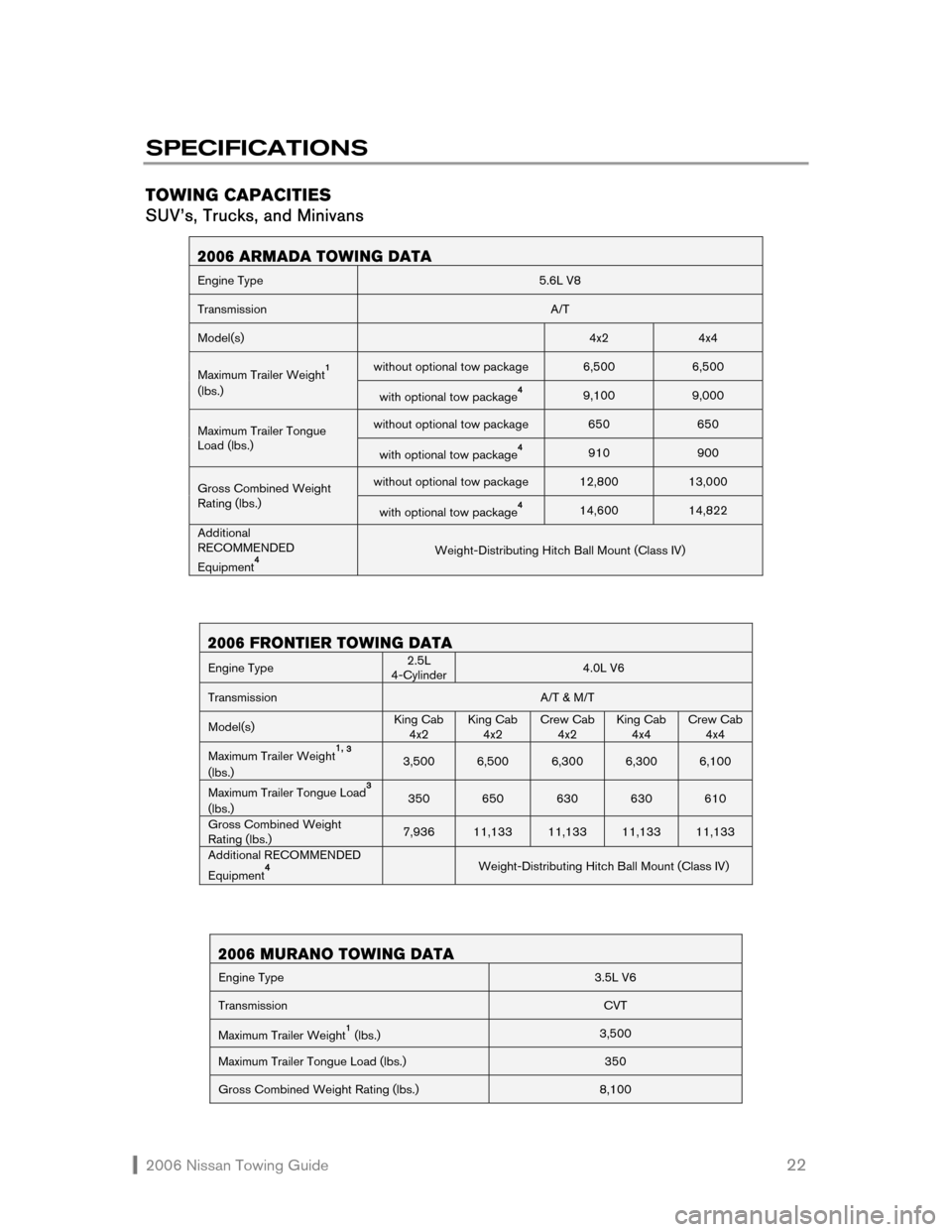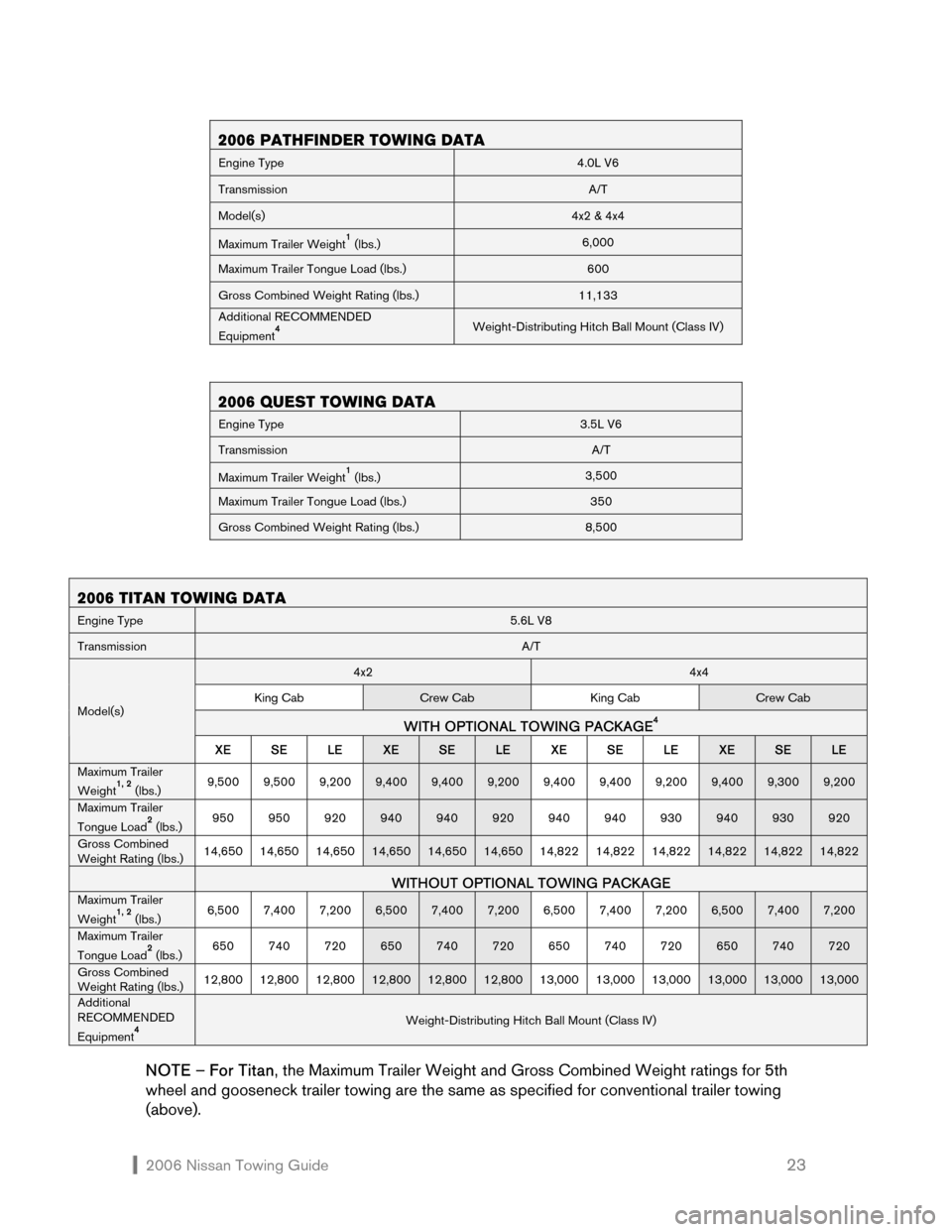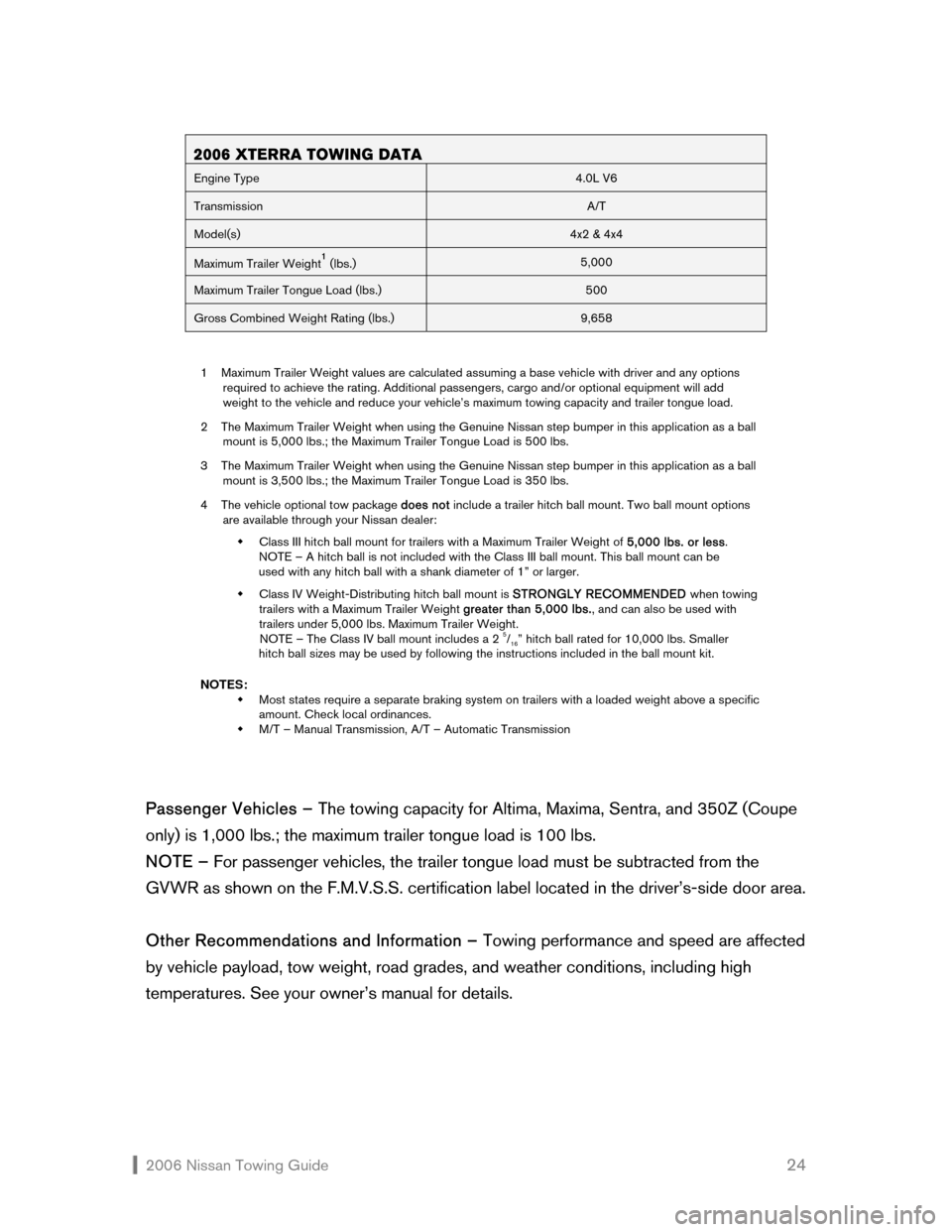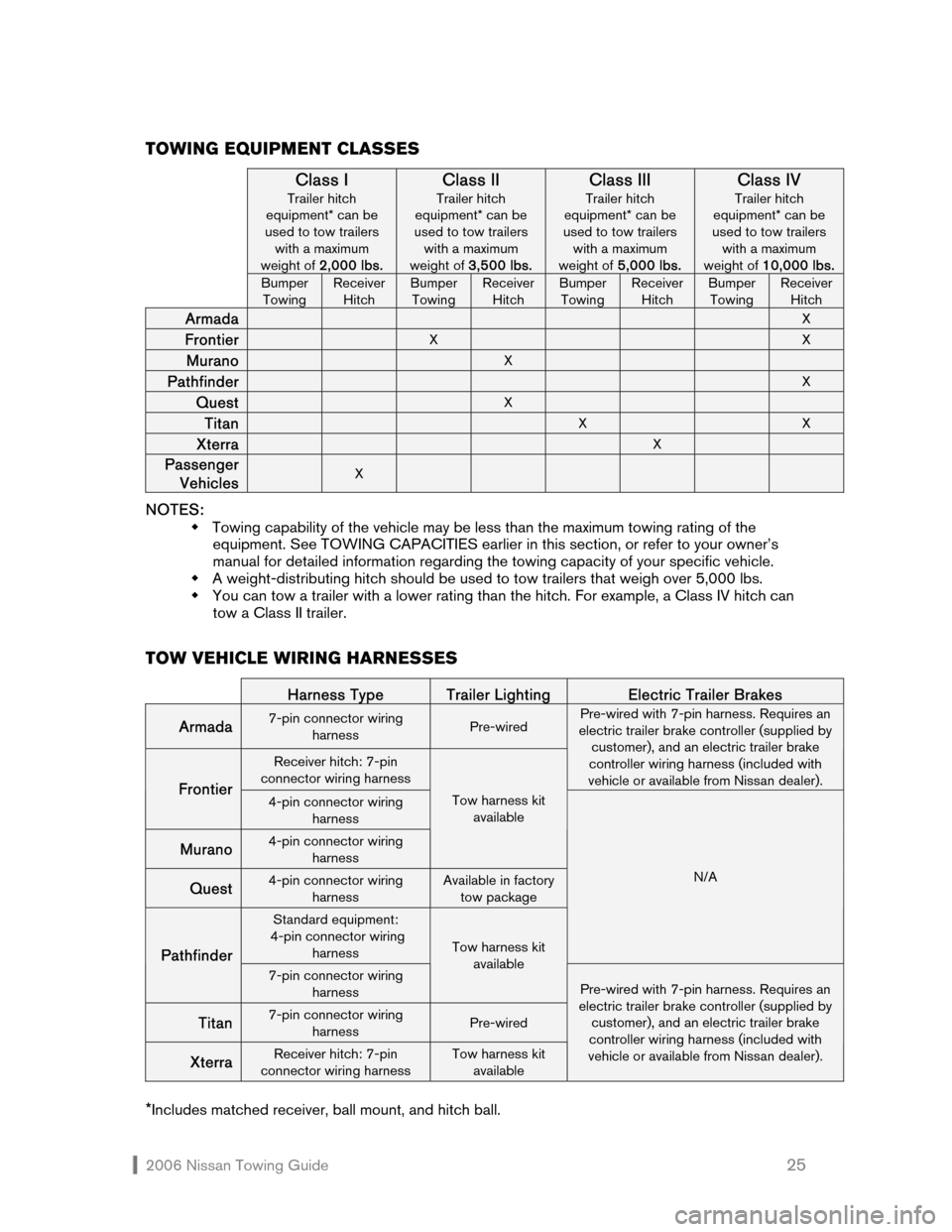2006 NISSAN QUEST trailer
[x] Cancel search: trailerPage 18 of 28

2006 Nissan Towing Guide 17
TOWING
TIPS
If you’ve never towed a trailer before, be aware that it does take getting used to. To begin
with, towing noticeably affects your vehicle’s performance:
�Š It will not accelerate as quickly — an important point to keep in mind when merging onto
a highway.
�Š It will not stop as quickly. Leave more room than usual between you and the traffic
ahead, and brake sooner when coming to a stop.
�Š Abrupt maneuvering can unbalance the load and reduce the handling stability of your
tow vehicle. Plan ahead and make lane changes and turns smoothly.
If possible, before you actually hit the open road, practice towing in a large, uncrowded
area such as a stadium or shopping center parking lot. Become especially familiar with
backing up a trailer — the maneuver many people find most difficult.
REDUCE SPEED
Drive your vehicle at a moderate speed, and remember to reduce your speed in unsafe or
less-than-ideal road conditions or weather. The tendency for a trailer to sway increases
with speed, and such swaying can result in a loss of control.
BRAKE SOONER
The combination of your tow vehicle and trailer obviously requires a greater distance to
stop. A good rule of thumb to remember is that for each 10 mph of speed, allow yourself
one tow vehicle and trailer length of distance between the front of your vehicle and the
vehicle ahead.
When braking, use firm but gradual pressure on the pedal rather than panic braking.
Applying the brakes abruptly or with too much force can cause the trailer to skid or
jackknife at its point of attachment with the vehicle. This, in turn, can throw the tow vehicle
out of control.
If equipped with an electric trailer brake controller, follow the recommended operational
instructions.
PASS CAREFULLY
As mentioned in the introduction to this section, because of the added weight of the trailer,
acceleration capability is reduced and you’ll require a longer distance to pass another
vehicle. Be certain you have sufficient time and space to pass safely. Obviously, never
attempt passing on hills or when going around curves.
Page 19 of 28

2006 Nissan Towing Guide 18 CORNER MORE SLOWLY
Know your vehicle and trailer capabilities. Entering a sharp corner too quickly or abruptly
can “crack the whip,” whereby the trailer can actually pull the tow vehicle off the road.
Therefore, when approaching a relatively sharp corner, begin braking sooner than you
would when not towing. Do your braking in a straight line prior to the corner, and turn
smoothly into it. In addition, remember to make a wider turn than normal to ensure that the
trailer safely clears the inside of the turn.
When towing a 5th wheel or gooseneck trailer, do not make sharp turns while driving or
backing as the trailer may contact the vehicle and cause damage to both the trailer and
vehicle. A special extended 5th wheel pin box or sliding hitch may be required to provide
additional trailer-to-truck clearance for tight maneuvering.
BACK UP WITH CAUTION
Backing up with a trailer is a difficult maneuver; however, there is a “trick” that can simplify
the procedure considerably. Simply steer with one hand at the bottom of the steering
wheel. To turn the trailer to the left, first move the steering wheel to the left. To turn the
trailer to the right, move the wheel to the right. All movements of the wheel should be done
in small increments. Of course, backing up should be done only at very slow speeds. For
large trailers that obstruct your rearward vision, have someone outside the vehicle act as a
“spotter” to guide you along.
PARK SMART
A tow vehicle and trailer can be an unwieldy combination in a small area, so always try to
park where you will have a relatively easy time maneuvering. Once parked, always block the
wheels on both the tow vehicle and the trailer.
Parking on a slope is not recommended. If, however, you must park on a slope, and your
vehicle is equipped with an automatic transmission, there are some precautions you should
take:
�Š Have someone block the wheels once the tow vehicle and trailer are in position and
being held by the vehicle’s brake.
�Š Next, apply the parking brake, and only then move the gear lever into PARK. If you move
the lever into PARK before blocking the wheels and applying the parking brake,
transmission damage may occur.
HIGH-ALTITUDE PERFORMANCE
An engine will lose about 4% of its performance for every 1,000 feet above sea level that
you travel. If you will be towing in high altitudes, it’s a good idea to allow more time than
usual due to the engine’s reduced performance.
Page 20 of 28

2006 Nissan Towing Guide 19 AUTOMATIC CRUISE CONTROL
Do not use cruise control while towing a trailer.
TOW MODE (IF EQUIPPED)
Tow Mode should be used when the vehicle and trailer weight is at least 75% of the
vehicle GCWR. This mode is most useful when towing a heavy trailer or hauling a heavy
load, particularly when stop-and-go traffic, rolling terrain, or a busy parking lot is involved.
Driving the vehicle in Tow Mode with minimal trailer load will not cause any damage;
however, fuel economy may be reduced, and transmission/engine driving characteristics
may feel different.
HILLS – UPGRADES
As the incline increases, shift down to a lower gear to maintain speed and prevent the
engine from lugging. However, for long and steep grades, do not stay in first gear when
driving above 35 mph or in second gear above 58 mph.* The added weight of a trailer
places an increased load on the engine and cooling system, so monitor your coolant
temperature gauge and automatic transmission fluid temperature gauge (if equipped) very
carefully. At the first sign of overheating, pull to the side of the road. See IF YOUR ENGINE
OVERHEATS later in this section for more information.
HILLS – DOWNGRADES
While going downhill, the weight of the trailer pushing on the tow vehicle may decrease
overall stability. Therefore, to maintain adequate control, reduce your speed and shift
to a lower gear.
When descending a hill, also avoid long or repeated use of the brakes as this reduces
their effectiveness and could cause overheating. Shifting to a lower gear instead provides
“engine braking” and reduces the need to brake as frequently.
IF YOUR ENGINE OVERHEATS
A moderate increase in engine operating temperature is normal when towing a trailer. If,
however, the coolant temperature gauge reading is abnormally high, or if you are
experiencing a significant loss of power, or if you hear unusual engine noises,** the engine
may be overheating and you should immediately take the following steps:
1. Pull your vehicle safely over to the side of the road, out of traffic. Apply the parking
brake, and move the gearshift lever to NEUTRAL (manual) or PARK (automatic). DO
NOT STOP THE ENGINE.
*For Murano, see your owner’s manual for information applicable to your vehicle.
**See your owner’s manual for additional indications that your vehicle may be overheating.
Page 22 of 28

2006 Nissan Towing Guide 21
TOWING
GLOSSARY
5TH WHEEL
HITCH Located just forward of the rear axle centerline, this hitch uses a king pin to serve
as the pivot point for the trailer.
BALL MOUNT A bar that holds the hitch ball and is inserted into the hitch receiver. Also
commonly called a drawbar or “stinger.”
BREAKAWAY SWITCH A safety device using a trailer battery that automatically applies the trailer’s
brakes if it should accidentally become separated from the tow vehicle. A
breakaway switch may be used with both electric or surge trailer brake systems.
BUMPER HITCH A reinforced bumper designed to accommodate a hitch ball.
ELECTRIC TRAILER
BRAKES When the brakes on a tow vehicle are applied, an electric current is sent to an
actuator which applies the trailer’s brakes.
ELECTRIC TRAILER
BRAKE CONTROLLER A device that controls the electric trailer brakes.
GOOSENECK HITCH Located just forward of the rear axle centerline, this hitch uses a ball to serve as
the pivot point for the trailer.
GROSS AXLE
WEIGHT RATING (GAWR) The maximum amount of weight each vehicle axle (front and rear) is designed to
safely carry.
GROSS COMBINED
WEIGHT RATING (GCWR) The maximum allowable combined weight of the vehicle and trailer, including
passengers and all cargo.
GROSS VEHICLE
WEIGHT RATING (GVWR) The maximum allowable weight of the vehicle, including passengers, cargo, fuel,
hitch, trailer tongue load, and any optional equipment.
KING PIN
LOAD The amount of trailer (5th wheel or gooseneck) weight pressing down on the tow
vehicle hitch.
HITCH BALL
A ball that connects the trailer to the tow vehicle hitch and provides the means
by which the trailer pivots during cornering. Available in a number of sizes and
weight capacities, it must correspond to the trailer coupler size, and have a
sufficient capacity rating for the trailer being pulled.
RECEIVER HITCH A frame- or structure-mounted hitch with a receiver that allows removal of the
ball mount.
SAFETY CHAINS/CABLES Provides an emergency connection between the tow vehicle and the trailer,
should the trailer become disengaged for any reason.
SURGE BRAKES
Hydraulic-type braking system activated by inertia. As the tow vehicle begins to
brake, the trailer pushes against the hitch ball, consequently activating the trailer
brakes.
TRAILER TONGUE/COUPLER The part of the trailer that extends forward to meet the tow vehicle, and also
carries the coupler assembly.
TRAILER TONGUE
LOAD The amount of trailer (conventional) weight pressing down on the tow vehicle
hitch.
WEIGHT-DISTRIBUTING HITCH
SYSTEM Type of hitch system that helps shift the trailer tongue weight to all trailer tires
and the tow vehicle front tires. Strongly recommended when towing trailers with
a Maximum Trailer Weight greater than 5,000 lbs.
WIRING HARNESS
Provides an electrical connection linking the tow vehicle’s electrical system to
the trailer’s system.
Page 23 of 28

2006 Nissan Towing Guide 22
SPECIFICATIONS
TOWING CAPACITIES
SUV’s, Trucks, and Minivans
2006 ARMADA TOWING DATA
Engine Type 5.6L V8
Transmission A/T
Model(s) 4x2 4x4
without optional tow package 6,500 6,500 Maximum Trailer Weight1
(lbs.) with optional tow package4 9,100 9,000
without optional tow package 650 650 Maximum Trailer Tongue Load (lbs.) with optional tow package4 910 900
without optional tow package 12,800 13,000 Gross Combined Weight Rating (lbs.) with optional tow package4 14,600 14,822
Additional RECOMMENDED
Equipment4
Weight-Distributing Hitch Ball Mount (Class IV)
2006 FRONTIER TOWING DATA
Engine Type 2.5L 4-Cylinder 4.0L V6
Transmission A/T & M/T
Model(s) King Cab 4x2 King Cab 4x2 Crew Cab 4x2 King Cab 4x4 Crew Cab 4x4
Maximum Trailer Weight1, 3
(lbs.) 3,500 6,500 6,300 6,300 6,100
Maximum Trailer Tongue Load3
(lbs.) 350 650 630 630 610
Gross Combined Weight Rating (lbs.) 7,936 11,133 11,133 11,133 11,133
Additional RECOMMENDED
Equipment4 Weight-Distributing Hitch Ball Mount (Class IV)
2006 MURANO TOWING DATA
Engine Type 3.5L V6
Transmission CVT
Maximum Trailer Weight1 (lbs.) 3,500
Maximum Trailer Tongue Load (lbs.) 350
Gross Combined Weight Rating (lbs.) 8,100
Page 24 of 28

2006 Nissan Towing Guide 23
2006 TITAN TOWING DATA
Engine Type 5.6L V8
Transmission A/T
4x2 4x4
King Cab Crew Cab King Cab Crew Cab
WITH OPTIONAL TOWING PACKAGE4
Model(s)
XE SE LE
XE SE LE XE SE LE XE SE LE
Maximum Trailer
Weight1, 2 (lbs.) 9,500 9,500 9,200 9,400 9,400 9,200 9,400 9,400 9,200 9,400 9,300 9,200
Maximum Trailer
Tongue Load2 (lbs.) 950 950 920 940 940 920 940 940 930 940 930 920
Gross Combined Weight Rating (lbs.) 14,650 14,650 14,650 14,65014,65014,650 14,822 14,822 14,822 14,822 14,82214,822
WITHOUT OPTIONAL TOWING PACKAGE
Maximum Trailer
Weight1, 2 (lbs.) 6,500 7,400 7,200 6,500 7,400 7,200 6,500 7,400 7,200 6,500 7,400 7,200
Maximum Trailer
Tongue Load2 (lbs.) 650 740 720 650 740 720 650 740 720 650 740 720
Gross Combined Weight Rating (lbs.) 12,800 12,800 12,800 12,80012,80012,800 13,000 13,000 13,000 13,000 13,00013,000
Additional RECOMMENDED
Equipment4
Weight-Distributing Hitch Ball Mount (Class IV)
NOTE – For Titan, the Maximum Trailer Weight and Gross Combined Weight ratings for 5th
wheel and gooseneck trailer towing are the same as specified for conventional trailer towing
(above).
2006 PATHFINDER TOWING DATA
Engine Type 4.0L V6
Transmission A/T
Model(s) 4x2 & 4x4
Maximum Trailer Weight1 (lbs.) 6,000
Maximum Trailer Tongue Load (lbs.) 600
Gross Combined Weight Rating (lbs.) 11,133
Additional RECOMMENDED
Equipment4 Weight-Distributing Hitch Ball Mount (Class IV)
2006 QUEST TOWING DATA
Engine Type 3.5L V6
Transmission A/T
Maximum Trailer Weight1 (lbs.) 3,500
Maximum Trailer Tongue Load (lbs.) 350
Gross Combined Weight Rating (lbs.) 8,500
Page 25 of 28

2006 Nissan Towing Guide 24
Passenger Vehicles – The towing capacity for Altima, Maxima, Sentra, and 350Z (Coupe
only) is 1,000 lbs.; the maximum trailer tongue load is 100 lbs.
NOTE – For passenger vehicles, the trailer tongue load must be subtracted from the
GVWR as shown on the F.M.V.S.S. certification label located in the driver’s-side door area.
Other Recommendations and Information – Towing performance and speed are affected
by vehicle payload, tow weight, road grades, and weather conditions, including high
temperatures. See your owner’s manual for details.
2006 XTERRA TOWING DATA
Engine Type 4.0L V6
Transmission A/T
Model(s) 4x2 & 4x4
Maximum Trailer Weight1 (lbs.) 5,000
Maximum Trailer Tongue Load (lbs.) 500
Gross Combined Weight Rating (lbs.) 9,658
1 Maximum Trailer Weight values are calculated assuming a base vehicle with driver and any options
required to achieve the rating. Additional passengers, cargo and/or optional equipment will add
weight to the vehicle and reduce your vehicle’s maximum towing capacity and trailer tongue load.
2 The Maximum Trailer Weight when using the Genuine Nissan step bumper in this application as a ball
mount is 5,000 lbs.; the Maximum Trailer Tongue Load is 500 lbs.
3 The Maximum Trailer Weight when using the Genuine Nissan step bumper in this application as a ball
mount is 3,500 lbs.; the Maximum Trailer Tongue Load is 350 lbs.
4 The vehicle optional tow package does not include a trailer hitch ball mount. Two ball mount options
are available through your Nissan dealer:
�Š Class III hitch ball mount for trailers with a Maximum Trailer Weight of 5,000 lbs. or less.
NOTE – A hitch ball is not included with the Class III ball mount. This ball mount can be
used with any hitch ball with a shank diameter of 1” or larger.
�Š Class IV Weight-Distributing hitch ball mount is STRONGLY RECOMMENDED when towing
trailers with a Maximum Trailer Weight greater than 5,000 lbs., and can also be used with
trailers under 5,000 lbs. Maximum Trailer Weight.
NOTE – The Class IV ball mount includes a 2 5/16” hitch ball rated for 10,000 lbs. Smaller
hitch ball sizes may be used by following the instructions included in the ball mount kit.
NOTES:
�Š Most states require a separate braking system on trailers with a loaded weight above a specific
amount. Check local ordinances.
�Š M/T – Manual Transmission, A/T – Automatic Transmission
Page 26 of 28

2006 Nissan Towing Guide 25 TOWING EQUIPMENT CLASSES
Class I
Trailer hitch
equipment* can be
used to tow trailers
with a maximum
weight of 2,000 lbs.
Class II
Trailer hitch
equipment* can be
used to tow trailers
with a maximum
weight of 3,500 lbs.
Class III
Trailer hitch
equipment* can be
used to tow trailers
with a maximum
weight of 5,000 lbs.
Class IV
Trailer hitch
equipment* can be
used to tow trailers
with a maximum
weight of 10,000 lbs.
Bumper
Towing
Receiver
Hitch
Bumper
Towing
Receiver
Hitch
Bumper
Towing
Receiver
Hitch
Bumper
Towing
Receiver
Hitch
Armada X
Frontier X X
Murano X
Pathfinder X
Quest X
Titan X X
Xterra X
Passenger
Vehicles X
NOTES:
�Š Towing capability of the vehicle may be less than the maximum towing rating of the
equipment. See TOWING CAPACITIES earlier in this section, or refer to your owner’s
manual for detailed information regarding the towing capacity of your specific vehicle.
�Š A weight-distributing hitch should be used to tow trailers that weigh over 5,000 lbs.
�Š You can tow a trailer with a lower rating than the hitch. For example, a Class IV hitch can
tow a Class II trailer.
TOW VEHICLE WIRING HARNESSES
*Includes matched receiver, ball mount, and hitch ball.
Harness Type Trailer Lighting Electric Trailer Brakes
Armada 7-pin connector wiring
harness Pre-wired
Receiver hitch: 7-pin
connector wiring harness
Pre-wired with 7-pin harness. Requires an
electric trailer brake controller (supplied by
customer), and an electric trailer brake
controller wiring harness (included with
vehicle or available from Nissan dealer). Frontier 4-pin connector wiring
harness
Murano 4-pin connector wiring
harness
Tow harness kit
available
Quest 4-pin connector wiring
harness
Available in factory
tow package
Standard equipment:
4-pin connector wiring
harness
N/A
Pathfinder
7-pin connector wiring
harness
Tow harness kit
available
Titan 7-pin connector wiring
harness Pre-wired
Xterra
Receiver hitch: 7-pin
connector wiring harness
Tow harness kit
available
Pre-wired with 7-pin harness. Requires an
electric trailer brake controller (supplied by
customer), and an electric trailer brake
controller wiring harness (included with
vehicle or available from Nissan dealer).